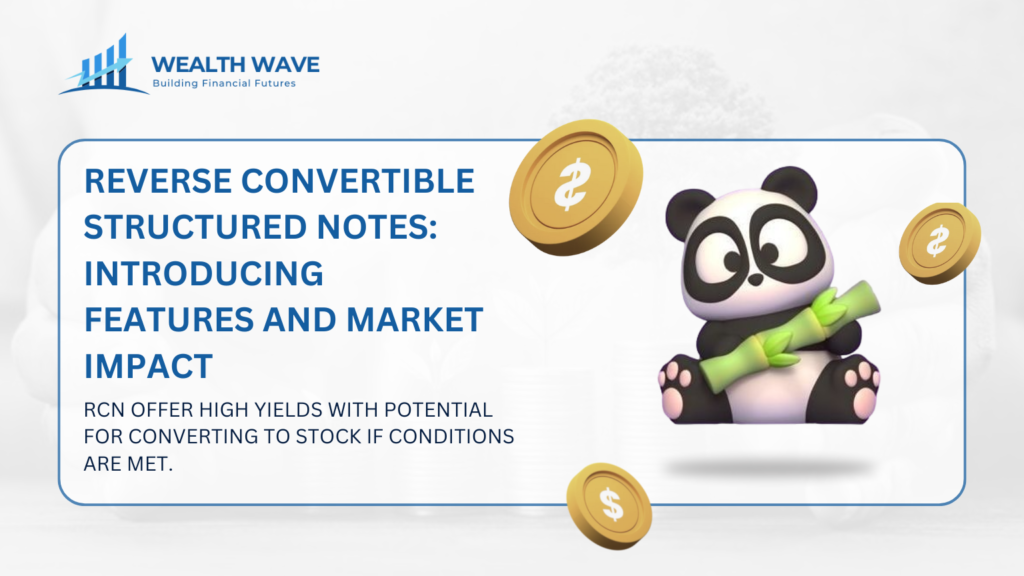We hear you loud and clear. Diving into the world of investments can often feel like embarking on a voyage across an endless ocean, fraught with both promise and perplexity. You’re not alone in feeling a bit adrift amidst the vast array of financial products, each claiming to be your north star towards wealth and security.
In our own exploration for secure yet profitable investment avenues, we encountered something quite out of the ordinary: Reverse Convertible Structured Notes. These instruments caught our eye with their intriguing mix—a cocktail of bonds and stocks, stirred with an embedded put option—boasting potentially high yields that beckon those willing to navigate their complexities.
Our team rolled up their sleeves, burrowing into the nitty-gritty of these hybrid securities to bring to light how they tick, who they’re best suited for, and what precautions should be heeded. During the term of Reverse Convertible Structured Notes (RCNs), investors receive fixed principal and interest payments. At maturity, the quantity of shares received, or the payoff depends on the stock’s level and the issuer’s creditworthiness.
This piece aims to guide you through the intricate dance of investing in Reverse Convertible Structured Notes, so you might find your footing on this challenging yet rewarding terrain.
Keep reading for insights wrapped in simplicity!
Key Takeaways
- Reverse Convertible Notes (RCNs) are unique investments that mix features of bonds and stocks, offering potentially high yields but with risks if the underlying stock’s price falls.
- These notes include an embedded put option, allowing investors to sell the underlying stock at a preset price, adding a layer of complexity and risk.
- RCNs are not guaranteed to protect your initial investment. If the stock does poorly, you may lose money or end up owning shares instead of getting cash back at maturity.
- They are suited for experienced investors who understand structured products and have a high tolerance for risk due to their non-principal protected nature and potential for significant losses.
- Liquidity can be an issue with RCNs because they might be hard to sell before maturity; understanding this is crucial when considering them as part of your investment portfolio.
- In Reverse Convertible Structured Notes (RCNs), the investor will receive periodic interest payments on this debt instrument. At maturity, the payoff is influenced by the knock-in price and can involve commodities or stocks. The investment is exposed to downside risk due to market volatility, which may impact the final return.
What are Reverse Convertible Notes (RCNs)?
Reverse Convertible Notes (RCNs) are a mix of bonds and stocks. They offer regular interest payments but can lead to losses if the underlying stock falls below a certain price.
Characteristics of Bonds and Stocks
Reverse Convertible Notes (RCNs) possess unique characteristics that blend features of both bonds and stocks. Like traditional bonds, RCNs pay fixed interest, offering a coupon-bearing investment option.
Reverse Convertible Structured Notes (RCNs) offer monthly or quarterly fixed coupon payments. Upon maturity, the investor may receive principal in cash or shares, depending on the stock’s price compared to the underlying asset’s price, differing from traditional corporate bonds by linking returns to stock performance.
Reverse Convertible Structured Notes (RCNs) offer potential benefits through stock and coupon payments, but it’s crucial to understand their downside protection and inherent risks.
These notes are often issued in denominations of $1,000 and can provide potentially high returns over their short-term maturity. However, they also include equity-like components due to their connection with the performance of underlying stocks.
Investor also should understand that while RCNs offer the promise of returning 100% of the original investment if the stock closes at or above its initial price at maturity, they are non-principal protected products.
This means there’s a risk involved; if the stock performs poorly, we could face significant losses. The interplay between these characteristics makes reverse convertible structured notes an intriguing yet complex addition to our investment portfolio.
Embedded Put Option
The embedded put option in a reverse convertible note offers us unique protection. This feature allows us, as investors, to sell the underlying stock at a predetermined price, known as the strike price, if the stock’s performance drops below that level.
If the stock closes at or above its initial price at maturity, we receive 100% of our original investment amount. However, should it fall below this point, we may end up receiving shares instead of cash.
This combination of characteristics makes reverse convertible notes hybrid securities that merge aspects of both fixed income and equity investments.
Understanding how payouts are determined will further clarify our investment journey with these structured products.
Coupon-Bearing Investment
Reverse convertible notes (RCNs) function as coupon-bearing investments. They typically provide a high-yield, short-term opportunity to earn interest. This investment allows us to receive periodic higher coupon payments during the note’s life.
However, these securities are non-principal protected short-term investments linked to specific underlying stocks. If the stock price falls below a certain level at maturity, our investment could be converted into shares instead of receiving our initial capital back.
With reverse convertible security, we often encounter an enticing payout structure that advertises potentially high returns. Each note usually costs $1,000 and features an embedded put option that adds complexity but also uniqueness to this hybrid security, which combines characteristics found in both fixed income securities and equity-linked notes.
How Do Reverse Convertible Notes Work?
Reverse Convertible Notes determine payouts based on the performance of an underlying asset. If that asset falls below a certain price, we may receive shares instead of cash at maturity.
Payout Determination
The payout for reverse convertible notes (RCNs) is determined by the performance of a specific stock at maturity. If the stock closes at or above its initial price, we receive 100% of our original investment amount.
This feature reflects the hybrid nature of RCNs as they tie both fixed income and equity investments together. In contrast, if the stock falls below this threshold, we may end up receiving shares instead of cash, resulting in potential losses since these investments are non-principal protected short-term options linked to fluctuating market conditions.
Understanding how these elements interact is crucial for managing risk while investing in such structured products.
Example
At maturity, the outcome of a reverse convertible note relies on the performance of the underlying stock. If this stock closes at or above its initial price, we would receive 100% of our original investment amount.
For instance, let’s consider a reverse convertible structured note linked to Company XYZ, which has an initial price of $50 per share. Upon maturity, if Company XYZ’s shares are trading at $55 or higher, we regain our full investment plus any accrued coupon payments.
Conversely, if Company XYZ’s share price drops below $50 and closes at $45 instead, we would not receive back our principal amount. Instead, our payout may be in the form of shares worth that lower closing value. In this context, the payout is linked to the performance of the underlying asset. If the stock price falls below the predetermined level during the term, the investor may receive less than the original principal, making it challenging to recover the full amount, similar to how an issuer might exercise a put option.
This situation underscores why these notes are classified as non-principal protected short-term investments tied to one or more underlying stocks. The potential for high returns comes with corresponding risks inherent in equity-linked notes like RCNs.
Risks of Investing in RCNs
Investing in Reverse Convertible Notes comes with unique challenges. We face greater risks due to their complex structure and the potential for significant losses if market conditions shift unexpectedly.
Complexity
Reverse convertible notes (RCNs) present an intricate investment landscape. These hybrid securities combine features of fixed income and equity investments, making them unique but challenging to understand.
The structure typically includes a short put option alongside a money-market placement, which can complicate their appeal. Investors should be aware that RCNs are non-principal protected short-term investments tied to specific underlying stocks.
The varying knock-in feature and structures of reverse convertible structured notes can introduce significant risk that requires careful consideration. With a potential for losses and the complexity of derivatives like equity-linked notes, we must approach these instruments with due diligence.
Understanding the barriers involved is crucial because they often carry high yields but also introduce additional risks that inexperienced investors might overlook.
Potential for Losses
Losses can occur with reverse convertible notes (RCNs) due to their non-principal protected nature. If the underlying stock closes below its initial price at maturity, we could receive less than our original investment amount.
This makes RCNs a risky choice for investors who may not fully understand structured products and their complexities. The payout is contingent on the performance of specific stocks, meaning an unfavorable market shift can lead to significant financial setbacks.
Investing in reverse convertibles requires careful consideration of risk management strategies as they can result in unexpected losses despite advertising high returns. Understanding these factors helps us navigate our investment choices effectively, especially when assessing who is suited for investing in RCNs.
Lack of Liquidity
Investing in reverse convertible notes (RCNs) can present challenges due to their lack of liquidity. These structured products are typically issued at $1,000 per note and often involve complex features that may discourage investors from buying or selling them in secondary markets.
Many financial institutions back these instruments; however, the unique payout structure creates uncertainties. If we choose to invest in RCNs, we must be prepared for the possibility that finding a buyer before maturity makes it difficult.
With RCNs classified as non-principal protected short-term investments linked to specific stocks, our exit options may be limited if market conditions change. As we navigate this investment landscape, understanding liquidity risk is crucial for making informed decisions regarding potential returns and losses associated with these hybrid securities.
Next, we will explore who might find investing in RCNs suitable based on experience and risk tolerance.
Who is Suited for Investing in RCNs?
Investors with experience and a high risk tolerance find RCNs appealing due to their unique structure. They understand how these products work and can handle the complexities involved.
For those who want to explore new investment opportunities, this might be an intriguing option.
Experienced Investors
Experienced investors often seek unique opportunities in the financial modeling markets. Reverse convertible notes (rcn) offer a blend of characteristics from fixed income and equity investments.
These non-principal protected short-term investments can yield high returns if tied to specific stocks. The structure involves both a short put and money-market placement, indicating that understanding their mechanics is crucial.
High risk tolerance is essential when engaging with RCNs due to their complexity and potential for losses if the underlying stock performs poorly. We recognize that these hybrid securities can be appealing, especially since they typically cost $1,000 per note.
Those well-versed in structured products are better positioned to navigate the intricacies associated with reverse convertible structured notes effectively.
High Risk Tolerance
Investing in reverse convertible notes (RCNs) requires a high risk tolerance. These structured products are non-principal protected short-term investments tied to specific underlying stocks.
Understanding this dynamic is crucial as the payouts at maturity depend heavily on stock performance. If the stock closes below its initial price, we could face significant losses.
We often seek high returns from these investment vehicles, which typically cost $1,000 per note and can promise enticing yields. The hybrid nature of RCNs combines elements of fixed income and equity investments, making them appealing yet complex choices for those ready to accept substantial risks.
As investors with a clear understanding of structured products, we navigate this unique landscape with caution and awareness of potential outcomes that lie ahead in our financial journey.
Understanding of Structured Products
Structured products, like reverse convertible notes (RCNs), combine characteristics of both fixed income and equity investments. They offer unique investment opportunities but come with inherent risks. In Reverse Convertible Structured Notes (RCNs), the investor receives a high fixed coupon rate and, upon maturity, may receive shares of the underlying stock or a payoff, depending on the share of the stock.
Reverse convertibles are non-principal protected short-term investments linked to one or more underlying stocks, typically issued by large financial institutions. Their payouts depend on the performance of a specific stock at maturity.
If the stock closes at or above its initial price, we receive 100% of our original investment amount.
Investing in RCNs requires a solid understanding of structured products due to their complexity and potential for losses. The structure often involves features such as embedded put options and coupon-bearing components that can make them appealing for those seeking high returns.
Yet, this allure comes alongside nuances that necessitate careful consideration before committing funds to these hybrid securities. Such awareness is crucial as we weigh whether these instruments align with our risk tolerance and investment strategies moving forward into assessing how they work practically.
Conclusion
We’ve explored the intriguing world of Reverse Convertible Structured Notes (RCNs) together. These investments blend characteristics of fixed income and equity, offering unique opportunities for those willing to embrace their complexities.
Understanding how a payout is determined can empower us as investors to make informed decisions. Would we consider if our investment strategy aligns with the risks RCNs carry? Let’s take that knowledge further and explore more resources on structured products.
Taking action today could lead us towards financial growth tomorrow!
FAQs
Q1. What are Reverse Convertible Structured Notes?
Ans. Reverse Convertible Structured Notes are a type of coupon-bearing investment. They're not principal-protected and can be linked to equity.
Q2. How do these notes differ from Convertible and Callable Bonds?
Ans. While convertible bonds can be changed into shares, callable bonds let the issuer pay back early. Reverse Convertible Structured Notes don't offer such options but may have higher returns due to risk.
Q3. Are Barrier Options related to these notes?
Ans. Yes, barrier options play a role in these notes as they set limits on when conversion happens based on the underlying asset's price.
Q4. How do Principal-Protected Notes compare to Non principal Protected Short-term Investment like Reverse Convertibles?
Ans. Principal-Protected Notes ensure your initial investment is safe regardless of market changes, unlike non principal protected short-term investments like reverse convertibles that bear more risk.




